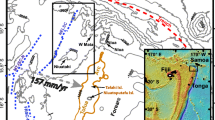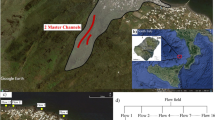Abstract
During the 1969–1974 Mauna Ulu eruption on Kilauea's upper east rift zone, lava tubes were observed to develop by four principal processes: (1) flat, rooted crusts grew across streams within confined channels; (2) overflows and spatter accreted to levees to build arched roofs across streams; (3) plates of solidified crust floating downstream coalesced to form a roof; and (4) pahoehoe lobes progressively extended, fed by networks of distributaries beneath a solidified crust. Still another tube-forming process operated when pahoehoe entered the ocean; large waves would abruptly chill a crust across the entire surface of a molten stream crossing through the surf zone. These littoral lava tubes formed abruptly, in contrast to subaerial tubes, which formed gradually. All tube-forming processes were favored by low to moderate volume-rates of flow for sustained periods of time. Tubes thereby became ubiquitous within the pahoehoe flows and distributed a very large proportionof the lava that was produced during this prolonged eruption. Tubes transport lava efficiently. Once formed, the roofs of tubes insulate the active streams within, allowing the lava to retain its fluidity for a longer time than if exposed directly to ambient air temperature. Thus the flows can travel greater distances and spread over wider areas. Even though supply rates during most of 1970–1974 were moderate, ranging from 1 to 5 m3/s, large tube systems conducted lava as far as the coast, 12–13 km distant, where they fed extensive pahoehoe fields on the coastal flats. Some flows entered the sea to build lava deltas and add new land to the island. The largest and most efficient tubes developed during periods of sustained extrusion, when new lava was being supplied at nearly constant rates. Tubes can play a major role in building volcanic edifices with gentle slopes because they can deliver a substantial fraction of lava erupted at low to moderate rates to sites far down the flank of a volcano. We conclude, therefore, that the tendency of active pahoehoe flows to form lava tubes is a significant factor in producing the common shield morphology of basaltic volcanoes.
Similar content being viewed by others
References
Carr MH (1974) The role of lava erosion in the formation of lunar rilles and Martian channels. Icarus 22:1–23
Cooper KM, Kauahikaua JP (1992) Morphology of extinct lava tubes and the implications for tube evolution, Chain of Craters Road, Hawaii Volcanoes National Park, Hawaii. US Geol Surv Open-File Report 92-352, pp 1–14
Cruikshank DP, Wood CA (1972) Lunar rilles and Hawaiian volcanic features: Possible analogues. The Moon 3:412–447
Davis JB (1859) Great eruption of the volcano Mauna Loa, in the Island of Hawaii. Edinburgh New Philos Jour, new ser 10:94–97
Duffield WA, Christiansen RL, Koyanagi RY, Peterson DW (1982) Storage, migration, and eruption of magma at Kilauea Volcano, Hawaii, 1971–72. J Volcanol Geotherm Res 13:273–307
Greeley R (1971) Observations of actively forming lava tubes and associated structures, Hawaii. Modern Geol 2:207–223
Greeley R (1972) Additional observations of actively forming lava tubes and associated structures, Hawaii. Modern Geol 3:157–160
Greeley R (1974) Kaumana lava tube. In: Greeley R (ed) Geologic guide to the Island of Hawaii. NASA CR 152416:233–238
Greeley R (1987) The role of lava tubes in Hawaiian volcanoes. In Decker RW, Wright TL, Stauffer PH (eds) Volcanism in Hawaii. US Geol Surv Prof Pap 1350:1589–1602
Greeley R, Hyde JH (1972) Lava tubes of the Cave Basalt, Mount St. Helens, Washington. Geol Soc Am Bull 83:2397–2418
Greeley R, Wilbur C, Storm D (1976) Frequency distribution of lava tubes and channels on Mauna Loa Volcano, Hawaii. Geol Soc Am Abst with Prog 8:892
Holcomb RT (1976) Preliminary map showing products of eruptions, 1962–1974, from the upper east rift zone of Kilauea Volcano, Hawaii. US Geol Surv Misc Field Studies Map MF-811, scale 1:24000
Holcomb RT (1980a) Preliminary geologic map of Kilauea Volcano, Hawaii. US Geol Surv Open-File Report 80-196, scale 1:50000
Holcomb RT (1980b) Kilauea Volcano, Hawaii: Chronology and morphology of the surficial hava flows. Stanford Univ PhD Thesis, pp 1–321. [Also US Geol Surv Open-File Report 81-354]
Holcomb RT (1987) Eruptive history and long-term behavior of Kilauea Volcano. In: Decker RW, Wright TL, Stauffer PH (eds) Volcanism in Hawaii. US Geol Surv Prof Pap 1350:261–350
Holcomb RT, Peterson DW, Tilling RI (1974) Recent landforms at Kilauea Volcano, a selected photographic compilation. In: Greeley R (ed) Geologic guide to the Island of Hawaii, NASA CR 152416:49–86
Hon K, Kauahikaua J (1991) The importance of inflation in formation of pahoehoe sheet flows (abstr). EOS 72:557
Hon K, Kauahikaua J, Denlinger R, McKay K (1994) Emplacement and inflation of pahoehoe sheet flows-observations and measurements of active lava flows on Kilauea Volcano, Hawaii. Geol Soc Am Bull 106:351–370
Hulme G (1974) The interpretation of lava flow morphology. Geophys J Roy Astron Soc 39:361–383
Jackson DB, Hort MKG, Hon K, Kauahikaua J (1987) Detection and mapping of active lava tubes using the ULF induction technique, Kilauea Volcano, Hawaii (abstr). EOS 68:1543
Jackson D, Kauahikaua J, Hon K, Heliker C (1988) Rate and variation of magma supply to the active lava lake on the middle east rift zone of Kilauea Volcano, Hawaii (abstr). Geol Soc A, Abstr Progr 20 (no. 7):A397
Johnson AM (1970) Physical processes in geology. Freeman, Cooper, San Francisco, pp 1–577
Kauahikaua J, Moulds T, Hon K (1990) Observations of lava tube formation in Kalapana, Hawaii (abstr). EOS 71:1711
Malin MC (1980) Lengths of Hawaiian lava flows. Geology 8:306–308
Moore JG (1975) Mechanism of formation of pillow lava. Am Scientist 63:269–277
Moore JG, Phillips RL, Grigg RW, Peterson DW, Swanson DA (1973) Flow of lava into the sea, 1969–1971, Kilauea Volcano, Hawaii. Geol Soc Am Bull 84:537–546
Peterson DW (1976) Processes of volcanic island growth, Kilauea Volcano, Hawaii, 1969–1973. Internat Assoc Volcanol Chem Earth's Interior, Symposium on Andean and Antarctic Volcanology Problems, Proc: 172–189
Peterson DW (1983) Processes of development of lava tubes at Mauna Ulu, Kilauca Volcano, Hawaii (abstr.). NSS Bulletin (Quart Jour Nat Speleolog Soc) 45, no. 1 (unpaginated)
Peterson DW, Holcomb RT (1989) Lava tubes at Mauna Ulu, Kilauea Volcano, 1972–1974 (abstr). New Mexico Bur Mines & Mineral Resources Bull 131:213
Peterson DW, Swanson DA (1974) Observed formation of lava tubes during 1970–71 at Kilauea Volcano, Hawaii. Studies in Speleology 2:209–222
Peterson DW, Christiansen RL, Duffield WA, Holcomb RT, Tilling RI (1976) Recent activity of Kilauea Volcano, Hawaii. Internat Assoc Volcanol Chem Earth's Interior, Symposium on Andean and Antarctic Volcanology Problems, Proc:646-656
Realmuto VJ, Hon KA, Kahle AB (1991) Mapping lava tubes, age relationships, and silicified regions in the Kupaianaha lava field with multispectral theraml infrared remote sensing (abstr). EOS 72:557
Rowland SK, Walker GPL (1990) Pahoehoe and aa in Hawaii: volumetric flow rate controls the lava structure. Bull Volcanol 52:615–628
Shaw HR, Swanson DA (1970) Eruption and flow rates of flood basalts. In: Gilmour EH, Stradling D (eds) Proceedings of the Second Columbia River Basalt Symposium. Eastern Washington State College Press, Cheney, pp 271–299
Sparks RSJ, Pinkerton H, Hulme G (1976) Classification and formation of lava levees on Mount Etna, Sicily. Geology 4:269–271
Swanson DA (1973) Pahoehoe flows from the 1969–1971 Mauna Ulu eruption, Kilauea Volcano, Hawaii. Geol Soc Am Bull 84:615–626
Swanson DA, Peterson DW (1972) Partial draining and crustral subsidence of Alae lava lake, Kilauea Volcano, Hawaii. US Geol Surv Prof Pap 800-C:1–14
Swanson DA, Jackson DB, Duffield WA, Peterson DW (1971) Mauna Ulu eruption, Kilauea Volcano. Geotimes 15, no. 5 12–16
Swanson DA, Duffield WA, Jackson DB, Peterson DW (1972) The complex filling of Alae Crater, Kilauea Volcano, Hawaii. Bull Volcanol 36:105–126
Swanson DA, Duffield WA, Jackson DB, Peterson DW (1979) Chronological narrative of the 1969–71 Mauna Ulu eruption of Kilauea Volcano, Hawaii. US Geol Surv Prof Pap 1056:1–55
Tilling RI, Peterson DW (1993) Field observation of active lava in Hawaii: some practical considerations. In: Kilburn CRJ (ed) Handbook for monitoring active lavas. University College London Press, 141–168
Tilling RI, Christiansen RL, Duffield WA, Endo ET, Holcomb RT, Koyanagi RY, Peterson DW, Unger JD (1987) The 1972–1974 Mauna Ulu eruption, Kilauca Volcano: An example of quasi-steady-state magma transfer. In: Decker RW, Wright TL, Stauffer PH (eds) Volcanism in Hawaii. US Geol Surv Prof Pap 1350:405–469
Walker GPL (1972) Compound and simple lava flows and flood basalts. Bull Volcanol 35:579–590
Walker GPL (1973) Lengths of lava flows. Roy Soc London Philos Trans A 274:107–118
Wentworth CK, Macdonald GA (1953) Structures and forms of basaltic rocks in Hawaii. US Geol Surv Bull 994:1–98
Wood C (1981) Exploration and geology of some lava tube caves on the Hawaiian volcanoes. Trans British Cave Res Assoc 8:111–129
Author information
Authors and Affiliations
Rights and permissions
About this article
Cite this article
Peterson, D.W., Holcomb, R.T., Tilling, R.I. et al. Development of lava tubes in the light of observations at Mauna Ulu, Kilauea Volcano, Hawaii. Bull Volcanol 56, 343–360 (1994). https://doi.org/10.1007/BF00326461
Received:
Accepted:
Issue Date:
DOI: https://doi.org/10.1007/BF00326461




